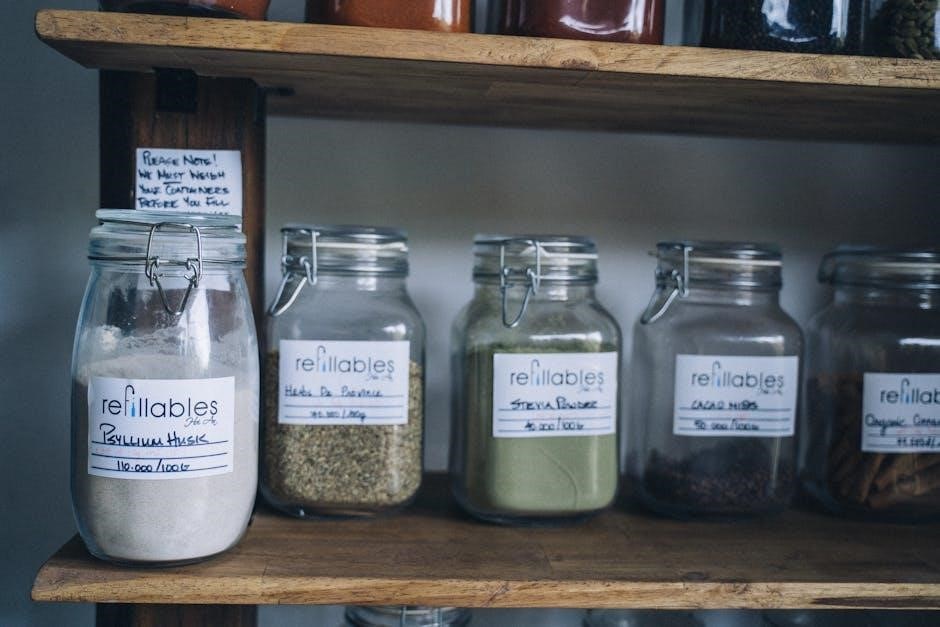100 foods before 1 pdf free
Welcome to the world of solid foods for your baby! Introducing solids around 6 months marks a significant milestone, providing essential nutrients for growth and development․ This guide explores 100 nutritious foods to help your baby thrive, supporting healthy digestion, motor skills, and lifelong eating habits․
Benefits of Introducing Solid Foods at 6 Months
Introducing solid foods at 6 months offers numerous benefits for your baby’s growth and development․ It helps meet their increasing nutritional needs, providing essential nutrients like iron and zinc․ Solid foods also support the development of chewing and swallowing skills, preparing your baby for a variety of textures․ This milestone encourages healthy digestion and reduces the risk of allergies when done gradually․ Additionally, it exposes your baby to diverse flavors, fostering a lifelong appreciation for different foods․ Starting solids at 6 months aligns with global health recommendations, ensuring optimal growth and development․ This period is crucial for laying the foundation of healthy eating habits and preventing nutritional deficiencies․ By introducing 100 nutrient-rich foods before age 1, you can ensure your baby thrives physically and developmentally․ This transition is a natural step in their journey toward independence and lifelong wellness․
Key Nutrients for Infant Growth and Development
Key nutrients are vital for supporting an infant’s rapid growth and development․ Proteins are essential for muscle development and tissue repair, while iron is crucial for brain development and preventing anemia․ Calcium and vitamin D support bone growth and strength․ Vitamin C aids in iron absorption and immune function, and B vitamins are important for energy production․ Fiber helps maintain healthy digestion and prevents constipation․ Healthy fats, particularly omega-3 fatty acids, are critical for brain and eye development․ Introducing a variety of whole foods ensures a balanced intake of these nutrients․ The “100 foods before 1” approach emphasizes incorporating diverse, nutrient-rich options to meet these needs․ By providing these essential nutrients, parents can support their baby’s overall health and developmental milestones during the first year of life․ A well-planned diet ensures optimal growth and lays the foundation for long-term health and well-being․
Top 100 Foods for Babies Before Age 1
Discover 100 nutritious foods for babies, focusing on fruits, vegetables, proteins, and whole grains․ These options support growth, digestion, and development while introducing diverse flavors and textures for a balanced diet․
High-Fiber Foods for Healthy Digestion
Introducing high-fiber foods to your baby promotes healthy digestion and prevents constipation․ Oatmeal, quinoa, and mashed beans are excellent sources of dietary fiber․ Steamed vegetables like carrots and peas also contribute to a balanced digestive system․ Incorporate these foods gradually to ensure your baby’s comfort and proper nutrient absorption․
Essential Fruits and Vegetables for Babies
Fruits and vegetables are crucial for providing babies with essential vitamins, minerals, and antioxidants․ Avocados, bananas, and mangoes are excellent first fruits due to their soft texture and nutrient-rich profiles․ Sweet potatoes, carrots, and peas are ideal vegetables, offering natural sweetness and vital nutrients like vitamin A and fiber․ Introduce these foods gradually, ensuring they are mashed or pureed for easy digestion․ Steamed apples and pears are also great options, while leafy greens like spinach can be added in small amounts for iron․ Always prioritize organic choices when possible and avoid added sugars or salts․ These foods help establish healthy eating habits and support overall development․ Include a variety of colors to ensure a broad range of nutrients․ Remember to monitor for any signs of allergy or intolerance when introducing new items to your baby’s diet․
Protein-Rich Foods for Muscle Development
Protein is vital for babies’ muscle growth and overall development․ Chicken and turkey are excellent first proteins, offering lean, easily digestible options․ Fish like salmon provides essential omega-3 fatty acids for brain and muscle health․ Eggs are another great source, rich in amino acids and iron․ Legumes, such as lentils and chickpeas, are perfect for plant-based protein․ These foods should be mashed or pureed for safety․ Introduce proteins gradually, starting with small portions to monitor for allergies․ Whole milk yogurt is also a nutritious choice, offering probiotics and calcium․ Protein-rich foods help build strong muscles and support energy levels․ Always ensure they are cooked thoroughly and free from seasonings․ These foods are foundational for a baby’s growth and development, making them a priority in their diet․ Include a variety of protein sources to ensure a balanced intake of nutrients․ This helps promote healthy muscle development and supports overall well-being during infancy․
Whole Grains for Optimal Nutrition
Whole grains are a fantastic source of essential nutrients for babies, providing fiber, vitamins, and minerals crucial for growth․ Oatmeal is a popular first food, offering iron and a smooth texture․ Brown rice is another excellent option, rich in B vitamins and manganese․ Quinoa, a complete protein, is ideal for babies, supporting muscle and brain development․ Barley and whole wheat cereals also provide sustained energy and fiber, aiding digestion․ Introduce grains gradually, ensuring they are well-cooked and mashed to prevent choking․ These foods help establish healthy eating habits and provide the energy needed for physical activity․ Incorporating whole grains into your baby’s diet ensures they receive a balanced mix of nutrients, supporting overall development and well-being․ They are a cornerstone of a nutritious diet, offering long-term health benefits․ Always choose single-ingredient, unflavored options to avoid unnecessary additives․

Food Safety and Allergy Prevention
Ensuring food safety and preventing allergies is crucial when introducing solids․ Wash utensils thoroughly, sterilize equipment, and introduce foods one at a time to monitor reactions․ Prioritize clean preparation and storage to safeguard your baby’s health․
Guidelines for Sterilizing and Storing Baby Food
Proper sterilization and storage of baby food are essential to ensure safety and freshness․ Always wash your hands and utensils before preparation․ Sterilize equipment and containers using boiling water or a steam sterilizer․ Store homemade baby food in airtight, clean containers or ice cube trays for portion control․ Label and date each container to track freshness․ Refrigerate cooked food within one hour of preparation and use within 3-5 days․ For longer storage, freeze food in portions, ensuring no cross-contamination․ Avoid refreezing thawed food․ When reheating, ensure food reaches a safe temperature (above 165°F) to kill bacteria․ Never leave prepared food at room temperature for extended periods․ Cleanliness and organization are key to maintaining safety and quality in baby food preparation․


Common Food Allergies in Infants
Identifying common food allergies in infants is crucial for their health and safety․ The most frequent allergenic foods include milk, eggs, peanuts, tree nuts, fish, shellfish, wheat, and soy․ Signs of an allergy may appear immediately or within a few days, ranging from mild rashes or itching to severe reactions like swelling, vomiting, or difficulty breathing․ In severe cases, anaphylaxis can occur, requiring immediate medical attention․ To prevent allergies, introduce single-ingredient foods gradually, monitor reactions, and consult a pediatrician before adding high-risk allergens․ Many resources, such as the “100 foods before 1” guide, provide detailed lists and strategies for safe introduction․ Early detection and avoidance of allergens help protect infants and promote a healthier start to their dietary journey․
Signs of Food Allergy or Intolerance
Recognizing signs of food allergy or intolerance in infants is vital for their well-being․ Common reactions include skin rashes, itching, redness, or hives․ Gastrointestinal symptoms such as diarrhea, vomiting, or bloating may also occur․ In severe cases, an infant might experience swelling of the face, lips, or tongue, difficulty breathing, or anaphylaxis, which requires immediate medical attention․ Food intolerance, unlike an allergy, does not involve the immune system but can still cause discomfort, such as digestive issues or irritability․ Parents should monitor their baby’s behavior and physical reactions after introducing new foods․ If any concerning signs appear, consulting a pediatrician is essential․ Tracking these reactions in a food diary can help identify problematic foods and guide safe dietary choices, ensuring a healthy and balanced introduction to solid foods․

Practical Tips for Parents
Plan meals with fresh, nutrient-rich ingredients to ensure variety and safety․ Gradually introduce new foods, monitoring for reactions․ Keep track of your baby’s preferences and reactions to build a balanced diet․

How to Prepare Homemade Baby Food

Preparing homemade baby food is a simple and healthy way to ensure your baby gets the best nutrients․ Start by washing and sterilizing all utensils and equipment․ Choose fresh, organic ingredients whenever possible, and ensure they are ripe for easier digestion․ Cook fruits, vegetables, and meats thoroughly until soft, then let them cool․ Use a blender or food processor to puree the ingredients to your baby’s desired consistency․ For thicker textures, add breast milk, formula, or water․ Avoid adding salt, sugar, or spices․ Store the prepared food in airtight, sterilized containers and refrigerate or freeze for later use․ Always check the temperature before serving, and discard any unused portions after 24 hours․ This method ensures freshness, safety, and customization to your baby’s needs, promoting healthy growth and development․

Storage Tips for Baby Food

Proper storage of baby food is crucial for maintaining freshness and safety․ Use airtight, BPA-free containers or ice cube trays to portion meals, making them easy to thaw and serve․ Label containers with the date and contents to ensure transparency․ Store pureed foods in the refrigerator for up to 3 days or freeze for up to 3 months․ Freezing helps retain nutrients and prevents spoilage․ Avoid refreezing thawed food to maintain quality․ When reheating, use a double boiler or microwave-safe dish, stirring well to avoid hot spots․ Always check for any signs of spoilage, such as an off smell or mold, before serving․ These storage tips ensure your homemade baby food remains nutritious and safe, while also saving time during meal preparation․ Proper storage also helps reduce waste and keeps meals organized for busy parents․
Common Mistakes to Avoid When Introducing Solid Foods
When introducing solid foods to your baby, there are several common mistakes to avoid․ Rushing the process or starting too early can lead to digestive issues, while delaying beyond 6 months may hinder developmental milestones․ Avoid adding excessive sugar or salt to baby food, as this can harm their taste preferences and health․ Over-reliance on single-ingredient foods may limit exposure to a variety of flavors and nutrients․ Additionally, never leave your baby unattended while eating to prevent choking hazards․ Incorrect storage methods can lead to food spoilage, so always use airtight containers and follow proper refrigeration or freezing guidelines․ Lastly, don’t assume your baby will immediately accept new foods; patience and consistency are key․ By avoiding these mistakes, you can ensure a smooth and healthy transition to solid foods for your baby․
